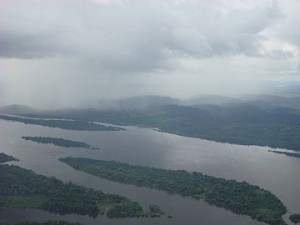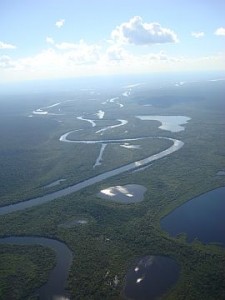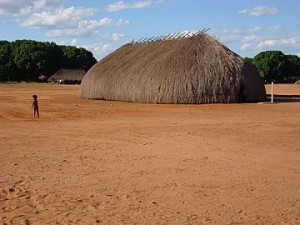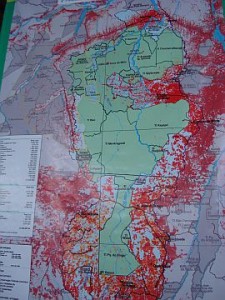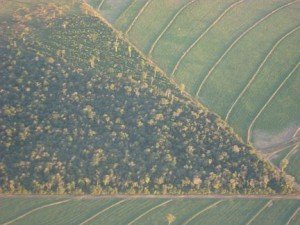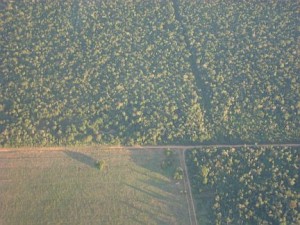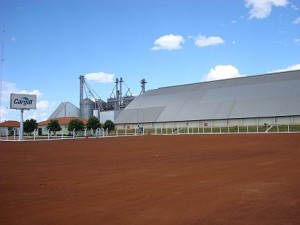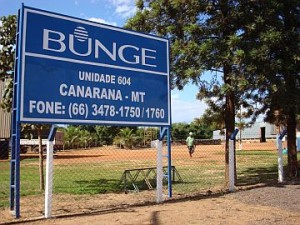After spending 4 days at the “Encontro Xingu”, I had the opportunity to fly over the entire Xingu river basin beginning in Altamira, Para and ending in Canarana, Mato Grosso…soy and cattle country. Since I didn’t have time to travel the entire length of the Xingu, like the Heart of Brazil Expedition did in 2007, I flew to see if it was really true if deforestation stops as soon as the Xingu Indigenous Reserve begins. I wasn’t alone. I was with my travel partner Scott Fitzmorris and two Indigenous elders who couldn’t bear the 60 hour bus trip to Canarana.
Since Altamira and the surrounding area around the Transamazonia highway are pretty much dominated by cattle ranching, there’s not much forest there. Leaving Altamira, however, it wasn’t long before the landscape was dominated by intact rainforest for as far as the eye could see. For about three hours, we flew over the Xingu river and the great forest that surrounds it. It was truly incredible and inspiring to see. At the beginning of the trip, the forest was flat, but then we crossed an area where the forest became mountainous. Then, it became flat again. That’s around the time I noticed a road all of a sudden. According to Jacalo Kuikuro, one of the elders who flew with us, this is the road that crosses the Indigenous Reserve. It is BR-80. I looked in the distance and saw what looked like cleared land. He said it was land cleared for soy. I asked him what he thought about the soy plantations surrounding the reserve and he said that he didn’t like it because the chemicals sprayed on the soy contaminate the rivers and kill the fish. Looking down at the Xingu river and all of the small rivers and channels that lead into it, I could see how chemicals from pesticide spraying miles away could have disastrous effects on the ecology and culture of the Xingu.
It wasn’t long before the plane began to descend and I noticed the changing landscape. I noticed less vegetation and more lakes. We were reaching the transition zone where the Amazon and the Cerrado, tropical wooded grassland, meet. This is an area of extreme biological and cultural diversity. For Indigenous people, like the Kuikuro, it is a sacred place that needs to be respected and protected.
Upon arrival of the Ipatse Kuikuro village, we were greeted by the village children and then introduced to Chief Afukaka. He welcomed us and led us to his house to talk. I told him about what we had seen from the air…the expansive forest, majestic river and soy plantations in the distance. He said, “When I was young, it was all forest. There were no soy plantations, but now as soon as you leave the Reserve it’s all soy plantations and cattle ranches. The chemicals from these huge farms cause lots of harm. When it rains all of the chemicals go into the rivers. Last year, a small river near our village was full of dead fish.” He also said, “Forests near the edge of our Reserve are burnt every year. When it rains, sometimes it rains black.” I told him about our campaign and he thanked me. He asked that I keep in touch with the young people in the community who are filmmakers working with “Video in the Villages” on films to preserve the Kuikuro culture. It turns out that I had already crossed paths with a couple of the young filmmakers a couple weeks ago in DC at the premiere of some their films at the Smithsonian National Museum of the American Indian. It’s a small world!
Shortly after leaving the Kuikuro community, we began to see the changing landscape, once again. This time, however, it was a drastic change where the forest ends and agribusiness begins. According to ISA, the SocialEnvironmental Institute in Canarana, 80,000 hectares of soy are in the Canarana area; 30,000 are in Agua Boa (south of Canarana); 40,000 are in Gaucha (west of Canarana); and 160,000 are in Querencia (north of Canarana). This soy expansion has occurred in just the last 13 years and is continuing. To get a better sense of what I’m talking about, look at this map and these photos.
It’s quite incredible! After flying over the Xingu and hearing the perspectives of Indigenous people like the Kuikuro, I find it pretty reprehensible that massive deforestation for agribusiness is occurring and continues to occur. Seeing the silos of Cargill and Bunge in Canarana convince me even more that the ABC’s of Rainforest Destruction need to be held accountable for the impacts they are causing to the world’s rainforests, local communities and our global climate.
